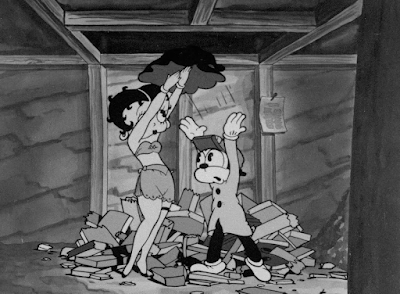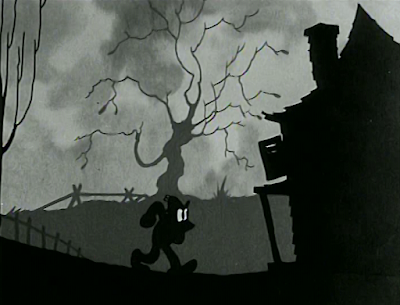Cartoons in the Golden Age were stuffed full of celebrity caricatures. Disney did them. Warners did them. Columbia did them. The Marx Bros. Kate Hepburn. W.C. Fields. Lantz’s Oswald even met FDR.
The idea went back to the silent days. Felix the Cat went to Hollywood in 1923 and ran into Charlie Chaplin. But an even earlier cartoon was released by Fox in 1918 featuring a huge movie star. Theda Bara may have been Hollywood's first bad girl, using sex to woo men to horrible fates. As Hollywood tends to do, it built up a huge, bogus background for her. As it turned out, she was plain old Theodosia Goodman of Cincinnati. Whether audiences eventually found her attempts at sultriness too comical or they just tired of her, Theda flamed out before the silent era ended and other screen sirens took her place.
Mutt and Jeff were hugely popular on the newspaper comics page, created by Bud Fisher in 1907 and still lamely taking up print space into the 1980s. Fisher worked out a deal with Charley Bowers in 1916 to bring the characters to the big screen. Not long after, with Fisher overseas on war duty, Bowers signed a states-rights distribution with Fox. One of Fox’s stars was Theda Bara. It seems only natural the two would get together.
Motion Picture World printed this story on July 6, 1918.
Two Screens Involved in This Mutt-Jeff-Bara Comedy
A REAL life personage and cartoon characters meet and act together on the screen in the Mutt and Jeff animated cartoon, "Meeting Theda Bara," which is announced from the William Fox offices as one of the latest of Bud Fisher's creations.
The picture is described as one of the funniest this comedy pair have yet appeared in. Jeff inherits a fortune and Mutt decides that they are going to become motion picture producers. Their aim is to secure the services of a vampire. This ambition is inspired after Mutt and Jeff see Miss Bara in a picture. Jeff's admiration for Miss Bara leads him to serve notice on Mutt that any "vamping" for the Mutt and Jeff Motion Picture outfit must be done by Theda Bara. Mutt laughs and informs his diminutive friend that a contract holds Miss Bara to produce solely for the Fox Film Corporation. The pair then go about obtaining a vampire in a scientific way.
It doesn't take Mutt long to convince Jeff that it's the eyes that make the vampire. He learns, however, to his chagrin, that he was only partly right. Jeff makes up his mind that he will drop around and see Miss Bara, so he picks out the stage door of a moving picture theater as the logical place to find the famous star. Mutt sees him there and thinks it is a great joke. Later sitting in a gilded restaurant, Mutt is still laughing at the idea of Jeff waiting at the stage door of a moving picture theater. However, there are two sides of the story, and Mutt didn't know that Jeff's side of the story was hidden by a screen that surrounded the table next to Mutt. Mutt's curiosity prompts him to peer over the top of the screen. What he saw on the other side caused him a surprise that you will have to see the picture to appreciate.
Other most recent Mutt and Jeff productions are "The Extra Quick Lunch," "Life Savers" and "The 75-Mile Gun." In "The Extra Quick Lunch," the pair open a restaurant in which speed and economy are the watchwords. Life Savers" show them at the beach, and in "The 75-Mile Gun" they capture the German super-gun and train it on the Kaiser and Von Hindenburg, with results disastrous to the leaders of Prussian kultur.
Here’s how the trade paper’s Hanford C. Judson reviewed the short in the same issue:
PROBABLY as amusing as any of this famous cartoon series is "Meeting Theda Bara," in which Jeff, after getting an inheritance, goes into the motion picture business with Mutt and they look about for a good vampire. Of course, Theda is the ideal, and while they want her, Mutt knows that she is under con- tract and is not to be thought of. Jeff perseveres and Mutt gets a knockout when he finds Jeff and Theda very friendly and taking dinner together in a restaurant.
A newspaper syndicate released the following review (the
Sunday Gazette of Atlantic City published it on June 30th):
FOR what is thought to be the first time in the history of motion pictures, a real life personage and cartoon characters meet and act together on the screen, in the Mutt and Jeff animated cartoon, Meeting Theda Bara, one of latest Bud Fisher creations.
Jeff inherits a fortune and Mutt decides that they are going to become motion picture producers. Their aim is to obtain the services of a vampire. This ambition is inspired after Mutt aud Jeff have seen Theda Bara in a picture. Jeff's admiration for Miss Bara leads him to serve notice on Mutt that any "vamping" to be done in their pictures must be done by Miss Bara.
The pair go about obtaining the services of Miss Bara in a scientific manner, and the adventures that befall them are said to make the picture the funniest this comedy pair have yet appeared in.
While Theda didn’t make it into the sound era, Mutt and Jeff did—in a way. In the 1930s, a number of the twosome’s shorts were colourised and had musical scores added to them. Then in 1973, it was done again by Fred Ladd, known for sending Warner Bros. and Fleischer cartoons to South Korea to be redrawn and splashed with colour for television, which was slowly getting out of the black-and-white business, with new musical backgrounds from various sources added.
If you're interested, here's a list of some of the other Mutt and Jeffs released around the same time. There was one a week.
MUTT AND JEFF ANIMATED CARTOONS.
Apr. 28— Helping McAdoo (Half-Reel).
May 6 — A Fisherless Cartoon (Half-Reel).
May 12 — Occultism (Half-Reel).
May 19 — Superintendents (Half-Reel).
May 26 — Tonsorial Artists (Half Reel).
June 2 — The Tale of a Pig.
June 9 — Hospital Orderlies.
June 16 — Life-Savers.
June 23 — Meeting Theda Bara.
June 30 — The Seventy-Five-Mile Gun.
July 7 — The Burglar Alarm.
July 14 — The Extra Quick Lunch.
July 21 — Hunting the U-Boats.
July 28 — Hotel de Mutt.
Aug. 4 — Joining the Tanks.
Aug. 11 — An Ace and a Joker.
To the best of my knowledge, no reels of
Meeting Theda Bara exist.
The Mutt and Jeff story gets a little murky in the 1920s. Bowers made some more cartoons in 1925-26, distributed by Short Films Syndicate. But so did some of his cartoonists, such as Manny Gould and Burt Gillett, who formed their own studio. Check out some of the unrestored shorts
courtesy of Cartoons on Film.



























































